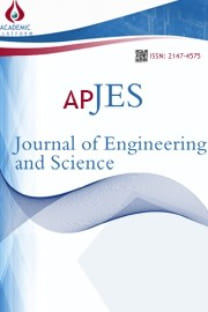FIR Filter Design Using Genetic Algorithm Implemented MATLAB and Asp.Net Based Web Educational Interface
___
- [1].J. M. Symons, L. C. Bradley, T. C. Cleveland, "The drinking water dictionary", American Water Works Association. Mc Graw Hill, 2000.
- [2].Ö. F. Tekbaş, G. Mahir, “Suların Sertlik Dereceleri ve Sağlık Etkileri,” TSK Koruyucu Hekim. Bülteni, vol. 3.7, pp. 156–161, 2004.
- [3].C. Gabrielli, G. Maurin, H. Francy-Chausson, P. Thery, T. T. M. Tran, and M. Tlili, “Electrochemical water softening: principle and application,” Desalination, 2006.
- [4].J. S. Park, J. H. Song, K. H. Yeon, and S. H. Moon, “Removal of hardness ions from tap water using electromembrane processes,” Desalination, 2007.
- [5].B. Boysal, F, Şengörür, “Su Sertliğinin İnsan Sağlığı İçin Önemi,” SAÜ Fen Bilim. Derg., vol. 13:1, pp. 7–10, 2009.
- [6].J. G. Dean, F. L. Bosqui, and K. H. Lanouette, “Removing heavy metals from waste water,” Environ. Sci. Technol., 1972.
- [7]. A. R. Hauck, S. Sourirajan, “Performance of porous cellulose acetate membranes for the reverse osmosis treatment of hard and waste waters,” Environ. Sci. Technol., vol. 3.12, pp. 1269–1275, 1969.
- [8].M. K. Nagarajan and H. L. Paine, “Water hardness control by detergent builders,” J. Am. Oil Chem. Soc., 1984.
- [9].B. H. Wiers, R. J. Grosse, and W. a Cilley, “Divalent and trivalent ion exchange with zeolite A.,” Environ. Sci. Technol., 1982.
- [10].S. Ghizellaoui, A. Chibani, and S. Ghizellaoui, “Use of nanofiltration for partial softening of very hard water,” Desalination, 2005.
- [11].K. H. Yeon, J. H. Song, and S. H. Moon, “A study on stack configuration of continuous electrodeionization for removal of heavy metal ions from the primary coolant of a nuclear power plant,” Water Res., 2004.
- [12].J. H. Song, K. H. Yeon, J. Cho, and S. H. Moon, “Effects of the operating parameters on the reverse osmosis- electrodeionization performance in the production of high purity water,” Korean J. Chem. Eng., 2005.
- [13].P. Čuda, P. Pospíšil, and J. Tenglerová, “Reverse osmosis in water treatment for boilers,” Desalination, 2006.
- [14].Y. Oren, “Capacitive deionization (CDI) for desalination and water treatment - past, present and future (a review),” Desalination, vol. 228, no. 1–3, pp. 10–29, 2008.
- [15].S. Porada, R. Zhao, A. Van Der Wal, V. Presser, and P. M. Biesheuvel, “Review on the science and technology of water desalination by capacitive deionization,” Progress in Materials Science. 2013.
- [16].M. E. Suss, S. Porada, X. Sun, P. M. Biesheuvel, J. Yoon, and V. Presser, “Water desalination via capacitive deionization: What is it and what can we expect from it?,” Energy and Environmental Science. 2015.
- [17].H. J. Ahn, J. H. Lee, Y. Jeong, J. H. Lee, C. S. Chi, and H. J. Oh, “Nanostructured carbon cloth electrode for desalination from aqueous solutions,” Mater. Sci. Eng. A, 2007.
- [18].J. F. Farmer, J. C., Fix, D. V., Mack, G. V., Pekala, R. W., & Poco, “Capacitive deionization of NaCl and NaNO3 solutions with carbon aerogel electrodes,” J. Electrochem. Soc., vol. 143(1), p. 159–169., 1996.
- [19].P. M. Biesheuvel and A. van der Wal, “Membrane capacitive deionization,” J. Memb. Sci., vol. 346, no. 2, pp. 256–262, 2010.
- [20].J. B. Lee, K. K. Park, H. M. Eum, and C. W. Lee, “Desalination of a thermal power plant wastewater by membrane capacitive deionization,” Desalination, vol. 196, no. 1–3, pp. 125–134, 2006.
- [21].T. J. Welgemoed and C. F. Schutte, “Capacitive Deionization TechnologyTM: An alternative desalination solution,” Desalination, vol. 183, no. 1–3, pp. 327–340, 2005.
- [22].H. I. Uzun and E. Debik, “Economical approach to nitrate removal via membrane capacitive deionization,” Sep. Purif. Technol., vol. 209, 2019.
- [23].P. Długołecki and A. Van Der Wal, “Energy recovery in membrane capacitive deionization,” Environ. Sci. Technol., 2013.
- [24].E. Debik, H. İ., Uzun, F. İlhan, Y. Avşar, “Yeni Bir Deiyonizasyon Prosesi: Kapasitif Deiyonizasyon,” Uluslararası Katılımlı Çevre Sempozyumu, vol. 1, pp. 172– 177, 2014.
- [25].S. J. Seo, H. Jeon, J. K. Lee, G. Y. Kim, D. Park, H. Nojima, J. Lee, and S. H. Moon, “Investigation on removal of hardness ions by capacitive deionization (CDI) for water softening applications,” Water Res., vol. 44, no. 7, pp. 2267–2275, 2010.
- ISSN: 2147-4575
- Yayın Aralığı: 3
- Başlangıç: 2013
- Yayıncı: Akademik Perspektif Derneği
Ancient Karez System in Afghanistan: The Perspective of Construction and Maintenance
Fiziksel Performans Etkisinde Mental Aktivitenin Elektrofizyolojik Bulgularının Değerlendirilmesi
Dilek GÖKSEL DURU, Elif Işıkçı KOCA
Harun Gül, Ali Osman Aydın, Mehmet Uysal, Ahmet Alp, Seda Ulu, Figen Özboz, Abdülkadir Akyol
Akın ÖZÇİFT, DENİZ KILINÇ, FATMA BOZYİĞİT
Ayasofya Müzesi Zemin Yüzey Deformasyonlarının Yeraltı Radarı (GPR) İle İncelenmesi
Efecan BELCE, Tolga BEKLER, Yunus Can KURBAN, CAHİT ÇAĞLAR YALÇINER
Emotion Detection with n-stage Latent Dirichlet Allocation for Turkish Tweets
Zekeriya Anıl Güven, Tolgahan Cakaloğlu, Banu Diri
Türkiye'de Telekomunikasyon Teknolojilerinin Yayılımı ve İkame Etkisi
Soğuk İklim Bölgelerinde Bitki Topluluklarının Sıcaklık Etkileri: Erzurum Ata Botanik Bahçesi
Mehmet Akif Irmak, Emral Mutlu, Hasan Yılmaz, Sevgi Yılmaz
Serbest Nilpotent Lie Cebirlerinin Otomorfizm Grupları Üzerine
